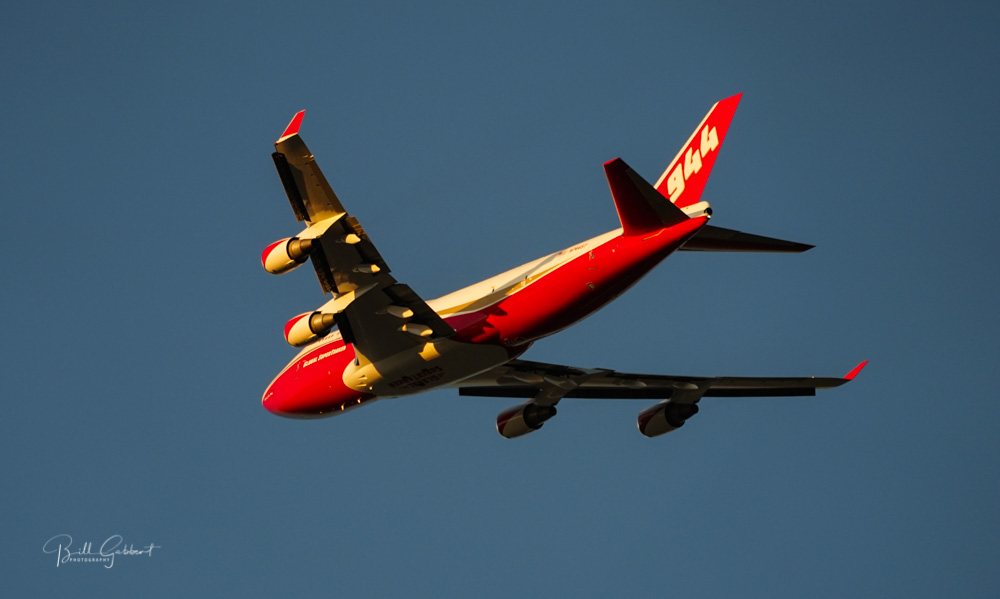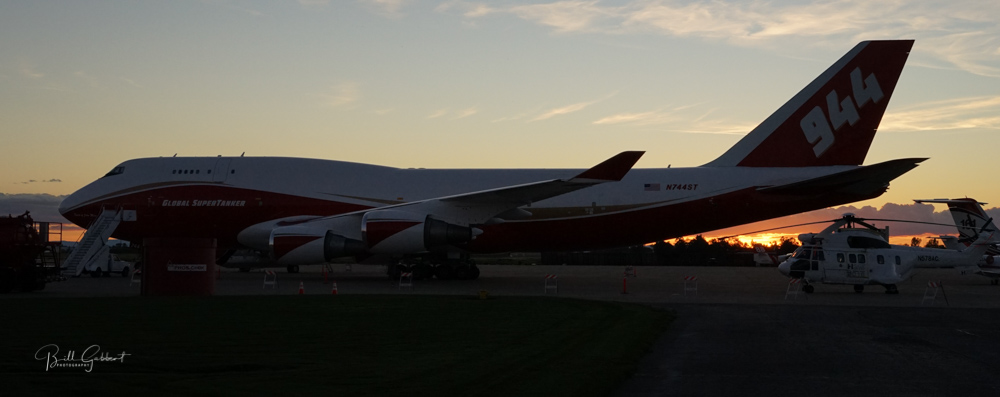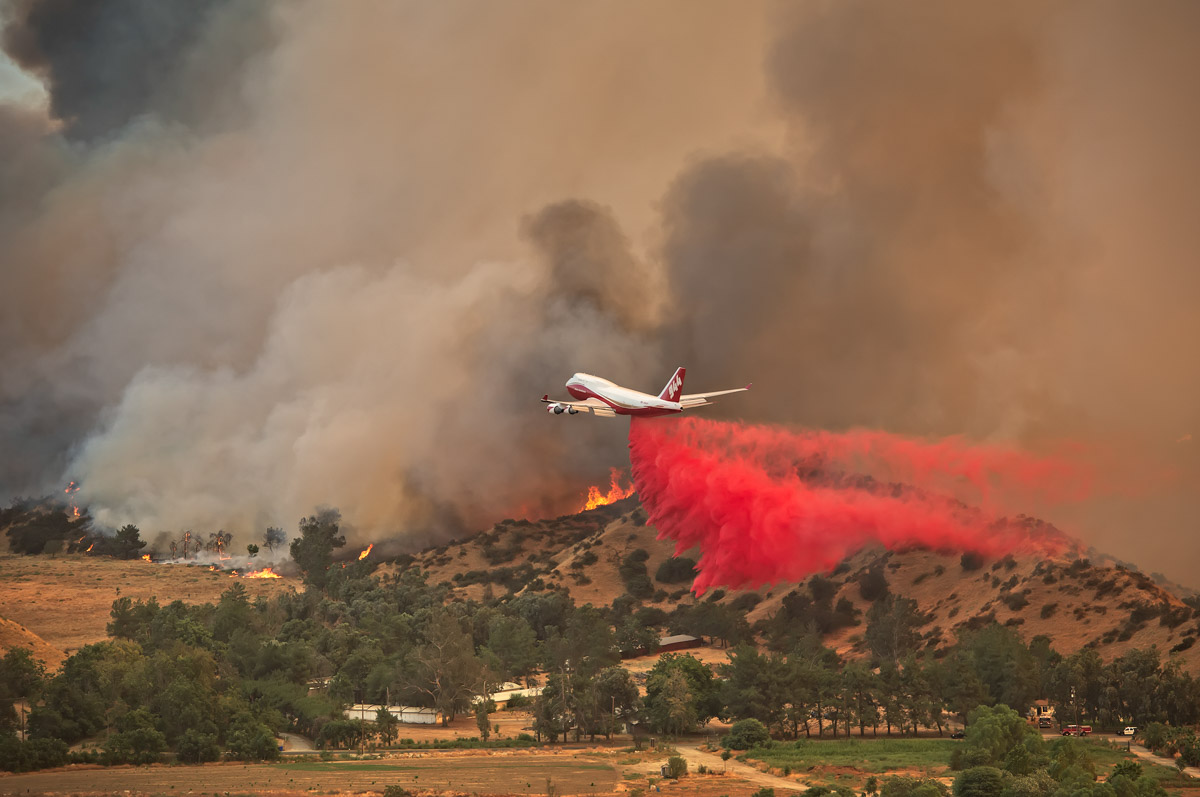Updated at 3:08 p.m. MDT April 23, 2021

This article was first published at Fire Aviation
The investor group that owns the 747 Supertanker, Tanker 944, is shutting down the huge air tanker. In an email sent April 21 to officials in Colorado, Oregon, Washington, and the federal government, Dan Reese the President of Global Supertanker gave them the news:
This week the investors that own the Global SuperTanker just informed me that they have made the difficult decision to cease operations of the company, effective this week…This is extremely disappointing as the aircraft has been configured and tuned with a new digital drop system and other upgrades to make it more safe and efficient.
Mr. Reese said in the email they are in discussions with prospective buyers, but it was unknown at that time if the aircraft would continue to be configured as an air tanker capable of carrying more than 17,500 gallons or if it would be used as a freighter.
Most of the company’s employees have been furloughed until the fate of the SuperTanker is known.

In an April 2020 letter posted on the National Wildfire Coordinating Group’s website the Chair of the National Interagency Aviation Committee, Joel Kerley of the Bureau of Indian Affairs, wrote to Global Supertanker Services saying the Committee would not issue a seventh interim approval of the aircraft’s retardant delivery system:
The Interagency Air Tanker Subcommittee does not support any further interim approvals without correcting some issues originally identified in the 2009 test of the system that included failure to meet coverage level 3 & 6, retention of retardant in the system after drop, aeration of the retardant causing trail off, and inconsistent flight profiles affecting retardant coverage.
Due to the current national situation regarding the Coronavirus (COVID-19), NIAC will issue an eighth interim approval to GSTS. However, NIAC will not support, nor issue a ninth interim until GSTS successfully passes all requirements of the 2013 IABS Criteria. This must be completed prior to December 31, 2020.

Last winter Tanker 944 spent several weeks in Moses Lake, Washington getting routine maintenance and a conversion of the retardant delivery system from an analog controller to a digital version, a change that was requested by the National Interagency Aviation Committee.
Most large air tankers carry up to 3,000 gallons of retardant. The 747 is capable of carrying far more retardant than any other. When first introduced it was listed at 20,000 gallons. Then the federal government certified it at 19,200 gallons. More recently it was required to carry no more than 17,500 gallons. The second-largest capacity air tanker is the Russian-made Ilyushin IL-76 at 11,574 gallons. The DC-10 until a couple of years ago was allowed to hold 11,600 but federal officials now restrict it to 9,400.
The U.S. Forest Service, the U.S. agency that contracts for all of the large and very large air tankers used by the federal government, has been slow to warm up to the concept of tankers that can carry more than 5,000 gallons. The California Department of Forestry and Fire Protection, CAL FIRE, accepted the concept of the 747 and DC-10 more quickly.
We asked the Forest Service for a comment on the demise of the 747. “The USDA Forest Service is aware of this vendors decision,” said Stanton Florea, Fire Communications Specialist for the agency.”The Global Super Tanker is on a Call-When-Needed (CWN) contract for aerial wildland fire suppression.”
In the interest of full disclosure, Global Supertanker Services has an ad in the sidebar of Fire Aviation.
Opinion of a Lead Plane Pilot
I asked a Lead Plane Pilot who has worked with Tanker 944 for his impressions of the aircraft. He is currently active and not authorized to comment publicly:
It’s a specialized tool, and as such it has a niche that it fills and in that niche there’s nothing else any better. That is, it puts out a huge amount of retardant in one pass, and that sometimes can be a great thing. It can travel halfway around the world and deliver product. Having said that it is also a specialized tool in that it isn’t very good at doing the little stuff.
I asked him about the retardant that sometimes trails off after a drop:
That trail off, that’s something they can beat them over the head with, but at the end of the day hardly anybody I know gives a s**t about it. Ok, well, it’s not a perfect tank.
Below is video of Tanker 944 dropping on the Holy Jim Fire on the Cleveland National Forest in Southern California in 2018.
First drop on a fire
The initial version of the Supertanker installed by Evergreen in a 747-100 made its first ever drop on a fire 12 years ago at the Railbelt complex in Alaska in 2009. When Evergreen went bankrupt Global Supertanker bought the hardware and the rights to the retardant system and installed it in a newer more powerful 747-400.
Assisted firefighters in Israel, Mexico, Chile, and Bolivia
In 2016 the 747 assisted firefighters in Israel, and in 2017 it spent several weeks working on fires in Chile. In one day, February 1, 2017 working out of Santiago, it conducted a total of 11 drops on 7 sorties. Six of the sorties were near Navidad and Matanzas 115 miles (185 km) southwest of the Santiago airport where many structures were threatened. The seventh was near Concepcion, 404 miles (650 km) south of Santiago. In total, 138,400 gallons (508,759 l.) were delivered to assist the firefighters on the ground.
The air tanker also had an assignment in Mexico in 2011, and in 2019 spent about seven weeks on a firefighting contract in Bolivia.

I should have indicated that a Type 3 helo is the lightest of the helos, it can drop water in a 100 gallon bucket. The Type 1 helos, the so called “helitankers” the largest of which can drop 3,000 gallons. Those of us who have mopped up fires in remote locations far from the access of engines and hose lays, know that too much water all at once can make mop up more difficult. The delivery of precisely dropped water in 100 gallon amounts can be extremely useful.
I have no firefighting experience, but your claims sound ridiculous. Mop up is the least of anyone’s concerns in regards to controlling fast moving fire lines with intense energy. Hundreds of gallon drops gets evaporated quickly and this emphasis on the necessity for exact precision is overstated. I have watched Type 3 helicopters struggle in relatively small fires over the past decade in the San Gabriel mountains. It is only the helitankers that make a significant difference because their loads are greater. From my experience watching large fires move across mountainous terrain, the absolute difference maker are VLTs of which the super tankers like the DC-10 and 747 are most effective. Those large tankers do have wind limitations that sometimes prevents their use.
I truly believe your logic will send aerial firefighting in the absolute wrong direction. How effective are your 100 gallon drops with the Caldor or Dixie fires? Give me a break.
I think the lead plane pilot’s comments are the best. Often times, those in the aviation industry and engineers in particular look at aircraft on a fire similar to a freight aircraft, the aircraft that can deliver the pounds to the destination. The more the better. But those of us who have worn out the soles of several pairs of boots on the ground look at things such as close delivery of the retardant (precision), the spread pattern and being able to maneuver in narrow steep canyons. In my experience the SEATS (single engine air tankers) can be more effective with their 800 gallons than a heavy (Type 1) air tanker might be. It is like the difference between a helo pilot in a Type 3 ship that can dump water from a bucket right on a narrow target as compared with a helitanker that can drop more water, but is often ineffective in getting that water to soak in on specific heavy fuels crews are trying to knock down and mop up.
From a pilot point of view bigger, more powerful is always better especially considering prestigious 747-400! But economically sure, it would be better to give everyone a job and fly a more versatile fleet.
Govt. Shuts it down. What a shame. Might as well let everything burn and blame it on the EPA.
Same Dan Reese that worked for Cal Fire AMU?
Too bad this plane was not been available for the Lolo Peak Fire, August 17, 2017.
Click HERE to see articles on Wildfire Today tagged “Lolo Peak Fire.”
The headline ought to say, “Government Shuts Down World’s Largest Fire Tanker”. It’s a damn shame when the government can’t get out of its own way & shuts down such a valuable and useful tool! These are one-off masterpieces. It’s not like they are rolling a million of these things off the assembly line every year and have all of the engineering, fabrication and production perfected. Clearly the benefit far outweighs any negative consequences. What’s next, the EPA forcing cutbacks in fire department’s use of water because of runoff and drainage???
It does a few things well. Versus, something that does a lot of things OK.
When we look at wildfire management and fiscal reality the money barrel is no longer bottomless. It has not been bottomless for a few decades now. We need more tools that can do more jobs; they don’t have to be perfect, they just have to work most of the time.
We have watched the number of airtankers available decrease over the years, but they got bigger. Bigger is not always better. At some point we will have to find a mix of airtankers that are not the biggest, but they have the best bang for the buck.
For the folks on the ground this makes sense. Fire shovel, pulaski, rake. I don’t need to have everything that the hardware store can sell me. If I look at water pumps, the Mark 3 is not perfect, but it suits the need most of the time.
The fire aviation world is changing fast. Those venerable aircraft that had the most versatility are starting to disappear. Instead of looking for the zoomy stuff (FireHog), or the giant stuff, maybe a fleet of AT802’s, CL415’s and C130’s, combined with some rotary-wing is the way to go?
ck
Hard to argue with that. Modern purpose built airframes is the way to go if for no other reason than the guys on board and the poor saps on the ground if something goes south. Air attacks best bang for the buck is on initial attack and once you have to use it for sustained attack the cost benefit ratio can often be rather poor. I can’t see the 747 or the DC 10 ever used for I/A purposes. You likely could have 6 802s for the operating costs of a single 747. Big aircraft are sexy to the public but not necessarily the right tool for the job. I strongly suspect the window for good utilization of this platform is likely quite small. The Air attack leaders who have worked with multiple aircraft would likely know the real story.